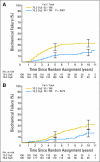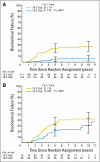Randomized trial comparing conventional-dose with high-dose conformal radiation therapy in early-stage adenocarcinoma of the prostate: long-term results from proton radiation oncology group/american college of radiology 95-09
- PMID: 20124169
- PMCID: PMC2834463
- DOI: 10.1200/JCO.2009.25.8475
Randomized trial comparing conventional-dose with high-dose conformal radiation therapy in early-stage adenocarcinoma of the prostate: long-term results from proton radiation oncology group/american college of radiology 95-09
Abstract
PURPOSE To test the hypothesis that increasing radiation dose delivered to men with early-stage prostate cancer improves clinical outcomes. PATIENTS AND METHODS Men with T1b-T2b prostate cancer and prostate-specific antigen </= 15 ng/mL were randomly assigned to a total dose of either 70.2 Gray equivalents (GyE; conventional) or 79.2 GyE (high). No patient received androgen suppression therapy with radiation. Local failure (LF), biochemical failure (BF), and overall survival (OS) were outcomes. Results A total of 393 men were randomly assigned, and median follow-up was 8.9 years. Men receiving high-dose radiation therapy were significantly less likely to have LF, with a hazard ratio of 0.57. The 10-year American Society for Therapeutic Radiology and Oncology BF rates were 32.4% for conventional-dose and 16.7% for high-dose radiation therapy (P < .0001). This difference held when only those with low-risk disease (n = 227; 58% of total) were examined: 28.2% for conventional and 7.1% for high dose (P < .0001). There was a strong trend in the same direction for the intermediate-risk patients (n = 144; 37% of total; 42.1% v 30.4%, P = .06). Eleven percent of patients subsequently required androgen deprivation for recurrence after conventional dose compared with 6% after high dose (P = .047). There remains no difference in OS rates between the treatment arms (78.4% v 83.4%; P = .41). Two percent of patients in both arms experienced late grade >/= 3 genitourinary toxicity, and 1% of patients in the high-dose arm experienced late grade >/= 3 GI toxicity. CONCLUSION This randomized controlled trial shows superior long-term cancer control for men with localized prostate cancer receiving high-dose versus conventional-dose radiation. This was achieved without an increase in grade >/= 3 late urinary or rectal morbidity.
Conflict of interest statement
Authors' disclosures of potential conflicts of interest and author contributions are found at the end of this article.
Figures



Comment in
-
Seduced by dose?J Clin Oncol. 2010 Mar 1;28(7):1087-9. doi: 10.1200/JCO.2009.26.5579. Epub 2010 Feb 1. J Clin Oncol. 2010. PMID: 20124163 No abstract available.
References
-
- Cooperberg MR, Broering JM, Litwin MS, et al. The contemporary management of prostate cancer in the United States: Lessons from the cancer of the prostate strategic urologic research endeavor (CapSURE), a national disease registry. J Urol. 2004;171:1393–1401. - PubMed
-
- Kupelian PA, Potters L, Khuntia D, et al. Radical prostatectomy, external beam radiotherapy < 72G y or > 72 Gy, permanent seed implantation, or combined seeds/external beam radiotherapy for stage T1-2 prostate cancer. Int J Radiat Oncol Biol Phys. 2004;58:25–33. - PubMed
-
- Zietman AL, Chung CS, Coen JJ, et al. 10-year outcome for men with localized prostate cancer treated with external radiation therapy: Results of a cohort study. J Urol. 2004;171:210–214. - PubMed
-
- Dearnaley DP, Sydes M, Graham JD, et al. Escalated dose versus standard dose conformal radiotherapy in prostate cancer: First results from the MRC RT01 randomised controlled trial. Lancet Oncol. 2007;8:475–487. - PubMed
-
- Al-Mamgani A, van Putten WLJ, Heemsbergen WD, et al. Update of Dutch multicenter dose-escalation trial of radiotherapy for localized prostate cancer. Int J Radiat Oncol Biol Phys. 2008;72:980–988. - PubMed
Publication types
MeSH terms
Grants and funding
LinkOut - more resources
Full Text Sources
Medical
Miscellaneous

